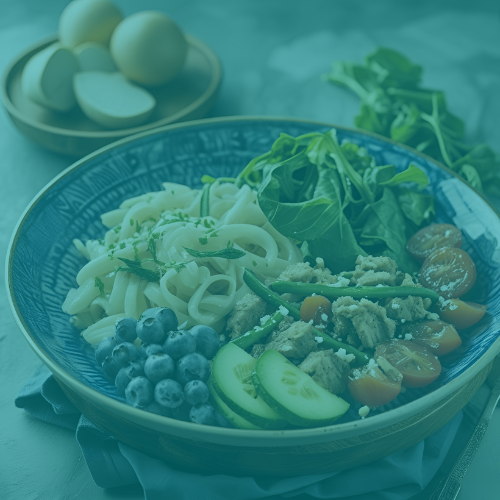The ‘Blue Zones’ Diet: What is it and should retailers invest?

The Blue Zones diet focuses on following a mostly plant-based diet, with an added emphasis on whole, unprocessed foods, moderate protein intake, and minimal red meat consumption.
It emphasises fruits, vegetables, legumes, beans, nuts and wholegrains, while recommending limiting dairy and added sugar.
The interesting part is there’s no one single Blue Zone diet. The term ‘Blue Zones’ originated from a National Geographic expedition. It sought to “uncover the secrets of longevity” in five places around the world where people often lived to more than 100 years old, without disease or declining health conditions, such as obesity or cancer.
These five areas are Okinawa, Japan; Nuoro Province, Sardinia; Ikaria, Greece; Nicoya, Costa Rica; and Loma Linda, California.
UK consumers are becoming increasingly keen to uncover the secrets of longevity and find out what they can apply to their diets. Google Trends data shows the number of UK-based searches for ‘blue zone diet’ began to grow in 2023, now sitting at its highest recorded level.
While a dedicated ‘Blue Zone’ display might not suit every convenience store, retailers report observing related trends among their shoppers. There’s an increased demand for products relating to plant-based diets and a healthy protein intake, and shoppers are looking for more unprocessed foods than ever before.
How is the Blue Zones diet followed in different areas?
A Blue Zones diet is different in each of the five areas:
- Okinawa, Japan - The main diet is low in calories, yet nutrient-dense. The foundation of the diet is root vegetables, more specifically, a purple sweet potato that is rich in protective polyphenols. Other components are fish, lean meat and spices.
- Nuoro Province, Sardinia - This Italian region primarily follows a plant-based diet that includes wholegrains, beans, garden vegetables and fruit, as well as sheep’s milk and cheese.
- Ikaria, Greece - Here, the diet is more traditionally Mediterranean, with a focus on fruit, vegetables, leafy greens, wholegrains, beans and olive oil.
- Nicoya, Costa Rica - Focuses on little-to-no processed foods in their diet, enjoying a consistent supply of antioxidant-rich fruit and veg, such as yams, corn and sweet potato.
- Loma Linda, California - This community follows a predominantly vegan diet of leafy greens, nuts and legumes. Some choose to consume dairy, eggs and fish as a side dish and in moderation.
Convenience store owners say their shoppers, particularly younger ones, are shopping with a health-conscious mindset and are looking to their local stores to support their healthier eating habits.
“Health-conscious shopping is already a huge driver for our sales and profits,” says Nishi Patel, owner of two Londis stores in Kent. “Retailers need to be active and try new things, even if they’re slow in the beginning.”
How can you profit from Blue Zones thinking in your store?
Break it down to its core values. The Blue Zones diet is made up of largely plant-based items, protein, eggs and dairy.
The good news is that most retailers are already equipped for this.
“Protein is now a key focus in our store, and customers are increasingly aware of its impact on their overall health,” Patel explains.
He has been experimenting with different protein lines and says offering high-protein meal options is an effective way to appeal to shoppers with health goals. This is because typically, high-protein meals are lower in calories.
This trend is also echoed by Vidur Pandya, owner of Kislingbury Mini Market & Post Office in Northamptonshire, but adds that he’s seen an increased demand for fresh produce, ‘cleaner’ ingredients and scratch cooking.
“Protein will influence our thinking when considering which healthier lines to invest in this year, but the Blue Zones diet is an interest in terms of the aspects that comprise it,” he says.
The rise of unprocessed foods – and who’s buying it
Processed products are a staple in British diets, with more than half of our calories coming from these foods. However, consumer concern about them is growing and while Brits remain less likely to be cutting down on them compared to their continental European counterparts, a third are planning to.
This increased awareness about the benefits of unprocessed foods could largely be attributed to social media’s role in educating consumers about potentially harmful ingredients.
Patel says as a result, it’s mainly Gen Z and Millennial consumers who would try a Blue Zones diet.
“Healthier diets used to be exclusively for gym-goers, but now Gen Z are buying more unprocessed and high-protein foods. They’re the health-conscious generation, and they’re looking at the ingredients in food now,” he says.
For retailers, this means stocking a broad range of fresh fruit and veg. As a value option, frozen fruit and veg are also strong alternatives as they’re frozen soon after picking.
If you’re looking to increase the amount of unprocessed food you offer, it might be worth considering whole foods, or looking for products that have fewer ingredients, which is what Pandya has noticed his customers doing.
“They’ll pick up a product and actively look at the ingredients,” he says. “They’re looking at how many E-numbers are present or for ingredients that they’ve not heard of before. Shoppers are more aware and educated than ever before.”
Interestingly, the demographics purchasing Blue Zones-adjacent products vary. While it’s Gen Z for Patel, Pandya says it’s mainly women and the older generations buying these products.
“We haven’t seen anyone younger than 25 looking at these diets,” he says. “Yes, they’ve been trying to be healthier, but for a Blue Zones diet specifically, it’s more women and the 35-55 demographic.”
Is there a future for the Blue Zones diet in the UK?
“These types of diets are on the rise, and as mainstream media picks up on it, more will choose to follow it,” Pandya says.
Pandya adds that he’s seeing related products hit the market, and says there’s good demand for retailers to get involved early.
Patel echoes this and adds, “It’s already here for us. We introduced ginger shots and other functional benefit drinks, and they’ve flown off the shelf. Yes, sales were a little slow at first, but they swiftly picked up.”
Get ahead of the curve by introducing a selection of lines that can appeal to consumers looking for healthier diets, which is where we come in.
- Creative Nature Fruit Oatie Bar – There are two flavours to stock, Oh Wow Cacao Bar and Bursting Berry Blend. Its ingredients include dates, apricots, cranberries and water.
- I Love Snacks Pouch - Natural Italian Olives - There are just two ingredients present in this product: olives and salt. It's vegan, vegetarian, gluten-free and contains just 55 calories per pack, making it ideal for Blue Zone diet followers.
- I Love Snacks Pouch - Natural Mango – With only 85 calories, it's 100% natural, plant-based and gluten-free. Similar to the above, the only ingredients are mango and citric acid.
Top tips for Blue Zones retailing
- Work with brands - While it’s a relatively new phenomenon, retailers are noticing brands are opting for unprocessed ingredients or increasing the amount of protein in their ranges. Attending trade shows or using wholesalers that specialise in these areas will help you find these.
- Find or create marketing materials - Marketing your range correctly is the quickest way to drive adoption. Most brands will have PoS ready, but if not, try creating your own or utilise social media to boost awareness.
- Don’t be afraid to try - Introducing new products can feel risky, especially if their popularity feels uncertain. However, the Blue Zones diet’s foundation in established healthy eating patterns may mitigate some of this risk. Don’t be afraid to lean in and try new products to cater for health-conscious customers – you never know, you might find a few hidden gems.

